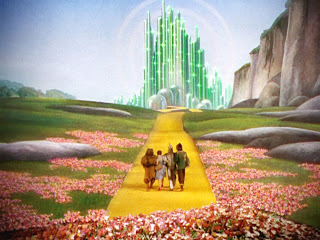I adore the Wizard of Oz.
And, although I was terrified of the Wicked Witch and hid behind the sofa for her parts, I loved watching the film as a child.
There was something utterly magical about the transformation from black and white to colour.
And, what colour it was.
Dorothy doesn’t just dream in colour, she dreams in Technicolor. The depth and saturation and the colour palette of eyepopping shades of red, green and yellow made for an enchanting and emotional addition to the story.
And that leads me into what I want to talk about here, which is how the use of certain technical devices in a work of art, such as colour, can help to persuade us to suspend our disbelief and enter into the story being told.
Suspension of disbelief is a term created by the Romantic poet, Samuel Taylor Coleridge and in the 21st century has come to refer to the willingness of the audience to set aside their knowledge that they are watching a film, or a play, or a show, and allow themselves to be swept away into the story, even if we dimly see the puppeteer pulling the strings.
When Dorothy steps through the sepia door and onto the very very yellow brick road, we understand immediately that we are in the realm of the fantastical. And, if we are willing to allow ourselves the freedom to go along with that journey, we may forgive any failings of costume or special effects.
We know the wool is being pulled over our eyes and we don’t care.
What, I hear you ask, does any of this have to do with photography and “Tales from the Moors Country?”
I’m so glad you asked.
I created “Tales from the Moors Country” for all adults who were in a similar position to me, when I worked in the City (yes, I was a stockbroker for seven long, long years). I created this body of work for people who wanted more magic and enchantment in their lives, people who remembered fondly a time when their imagination was more easily engaged.
In doing so, I employed certain techniques to communicate that magic and imagination to my audience. Localised saturation of certain colours, a general softness that is unusual to most photographs, and improbable movements all serve to clearly show the viewer that this is not supposed to be real. This is a storybook world.
And yet.
The question I am asked most often about “Like Ghosts from an Enchanter Fleeing” is “Were the leaves actually there, or have they been added in later?” Many of my other images provoke similar questions.
It’s an understandable question. But every time someone asks it, somewhere a fairy drops dead and a little piece of me dies. Because I know I have failed.
I have failed in my job to remind you of a time when life was more enchanting. A time when it didn’t matter if the story was real or not. A time when you danced and sang without self consciousness.
I have failed in my job to remind you of your own creativity, your own imagination. I have failed in my job to remind you of the tools you have that help you to face a life that is so much more complicated than we wish it was.
I have failed in my job to stay hidden behind the curtain.
Just like Dorothy in the Emerald City, we don’t actually want to see the man behind the curtain. Because, when we do……we know he can’t make our dreams come true. We know that he can’t transport us anywhere, that he’s just a man and not really a wizard at all.
Reality is overrated.
After seeing the wizard for what he truly is, Dorothy finds her own power to return home to her sepia world and vows never again to wander beyond her own backyard. The implication in the film, if not in the books on which it is based, is that she will marry a Kansas farmer, start popping out kids, and never again dream in Technicolor.
For my part, I would rather my ruby slippers take me back to Oz, or to Narnia, or to Wonderland, rather than back home. I would rather dream in Technicolor. I would rather suspend my disbelief. I would rather talk about the why, rather than the how. This is why I will often disappoint those who ask me how I have accomplished a particular effect. Because seeing the man behind the curtain means it’s time to go home. And I want you to stay a little longer with me. And you want that too, don’t you?


